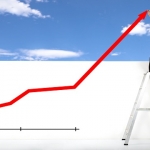Is 6% a good return on your investment? In Part I of the our blog, we discussed the likelihood that investment returns may be below average for the next few years and suggested that a globally diversified portfolio may generate a return of around 6-7% during this period. If so, then it is reasonable to question whether this low of a return is satisfactory and evaluate how the return compares to historical norms.
The investment return for a diversified portfolio has historically been substantially higher than 6%, and for several periods of time achieved gains of 10-12%.
Why would it be reasonable to settle for a lower rate of return in the future if the past has been so much better?
The answer lies in the relative returns in comparison to the rate of inflation.
Inflation is defined as a sustained increase in the general level of prices for goods and services. The negative effect of inflation is that it erodes purchasing power and therefore the value of a dollar over a period of time. By way of example, if inflation is 9%, a dollar would provide the purchasing power of only 42 cents after a period of ten years. In the decades of the 1970’s and 1980’s the US experienced this type of inflationary environment.
As an investor, one of the primary goals is to protect against this erosion of purchasing power, and ideally even provide a certain amount of growth beyond the rate of inflation. Growth experienced above the inflation rate is known as the “real” rate of return. For example, if an investor achieves a 10% investment return, and inflation is 6%, the real rate of return would then be 4%. Historically, a 3-4% real return has been achievable and is a reasonable expectation for future results as well.
More recently, in 2014, the inflation rate for the US economy was astoundingly low at just under 1%. The risk of losing purchasing power is therefore mitigated in such an environment. Correspondingly, the portfolio return required to outpace inflation is lower as well. This is the good news for investors with long time horizons. The bad news is that returns for the various markets will likely be lower (as explained in Part I of the blog) and therefore growth in dollar values of a portfolio may appear subdued when compared to historical averages.
Again, by way of example, if a portfolio is expected to now only achieve a return of 6%, but inflation is only 1%, then the real rate of return is 5%, and would actually be higher than historical averages. Our expectation, however, is that inflation will increase slightly to between 2-3% over the next few years. The end result is that real returns for a diversified portfolio may be in line with historical norms and a sustained period of double digit returns is unlikely. This may be particularly difficult to swallow, especially with the amazingly strong returns experienced from 2009 to 2014 fresh in our minds. It will be just as important as ever to stay the course, since a well-structured portfolio will be perfectly capable of not only preserving purchasing power, but will also be able to provide very reasonable real rates of return. The old saying that “patience is a virtue” will never hold more true.
To learn more about David Wilder, view his Paladin Registry profile.
Other posts from David Wilder
Is Anyone Managing Your 401(k)?
Many investors have a 401(k) or 403(b) retirement plan that includes limited investment options and, as a result,...
Are New Stock Market Highs a Concern?
With many stock indexes such as the Dow Jones Industrial Average and the S&P 500 hitting new market...
Investment Returns Revisited– Part I
Looking back at 2015, which was a flat year for most major asset classes, it is reasonable for investors...





